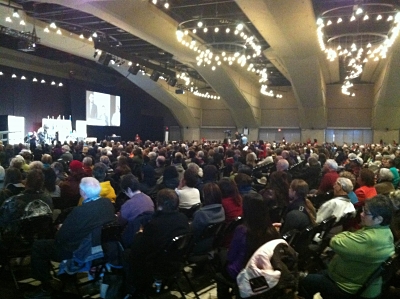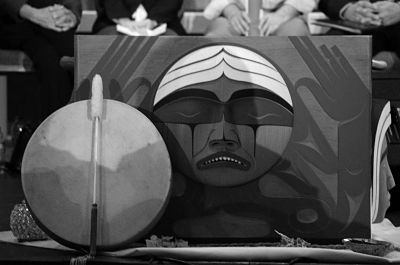Truth commissions can be seen, not only as venues for addressing the worst abuses of states in a search for justice, but as institutions that produce knowledge, oriented toward shaping opinion on a wide scale. The public orientation of the commission is shaped in important, but largely unrecognized ways, by the laws that bring the commissions into being, the powers they possess, and the approach they take to the “victims” or “survivors” of the abuse of states. The influence of the law can be seen in the preferences and absences of Commission proceedings; this includes the templates that shape survivor testimony, and conditions of moral affirmation and insecurity that influence the presence or absence of those who give testimony and how their statements are received.
These basic observations on the connection between the mandates of truth commissions and their production of knowledge are particularly salient in Canada’s ongoing Truth and Reconciliation Commission on Indian residential schools. The Commission began its work in 2009 with little public awareness or acknowledgment of the history of the human rights abuses in question: the institutional effort to assimilate “Indians” into mainstream Canadian society through a large scale effort of church-operated residential schools that removed children from their communities and families. Spanning a period of approximately one hundred years, from the late nineteenth century to the late twentieth century, the federal government of Canada put into effect a policy of Indian education through residential schools, based largely on an already established U.S. model of Indian boarding schools. The main distinguishing quality of Canada’s residential school program was that it involved collaboration between the federal government and a variety of churches: Anglican, Catholic (especially the Oblates of Mary Immaculate), Presbyterian, and United. By the time the last schools closed in the mid-1990s, approximately 140 Indian residential schools housing approximately 150,000 children had been in operation. There are some 86,000 people alive today who once spent time as a child in an Indian residential school. And it is their removal from their families and their frequent experience of abuse in the schools that was at the origin of the lawsuit in the early 2000s that resulted in a Settlement Agreement, a costly regime of compensation (costing the federal government more than three billion dollars CDN, and counting) and a truth and reconciliation commission, intended in part to uncover important “truths” about the schools and make them known to a largely uninformed Canadian public.
The work of the commission was therefore oriented toward the persuasion of others concerning its basic premises. To an unusual degree among truth commissions, it faced the challenge of persuasion, of convincing public audiences that the reality depicted in the trials and negotiations leading up to the Settlement Agreement has a historic dimension that calls for reform of the dominant narrative of the state.
Another important quality of Canada’s Truth and Reconciliation Commission has to do with the extent to which its terms of reference separate it from judicial proceedings or powers. The mandate of the TRC was constructed through the negotiations of the Settlement Agreement, under the terms of which the TRC is prevented from holding formal hearings, acting as a public inquiry, or conducting any kind of legal process. It is, in other words, designed as an information-gathering rather than a judicial body. It does not have subpoena powers, and has no other mechanism to compel attendance or participation in any of its events or activities. It is even prevented from “naming names,” from identifying any person in any of its activities or reports without the consent of that individual, unless the identity of that person has already been established through legal proceedings (i.e. convicted of the alleged wrongdoing).
There will be no dilemma at the conclusion of the Commission concerning what to do with the identities of possible perpetrators, because there never will be a list of names; the Commission has been prevented by its terms of reference from receiving them into the record in the first place.
Nor is it permitted to make reference in its reports or recommendations to any possible civil or criminal liability of any person or organization. In comparative terms, it can be situated squarely among “victim-centred” truth commissions, such as those in Rwanda and Nigeria, established in the aftermath of ethnically-based violence. It has been from the outset released into a limited enclosure, with no range of authority that might lead to some sort of reckoning-for-the-responsible or extend the information it receives beyond a focus on victim narratives.

Working within the limits of this mandate, the Commission has taken its work in a distinct direction: the emotionally laden, powerful testimony presented to the commission has, in a relatively short period of time, become not only “sayable” but has become dominant to the point of excluding or overshadowing other forms of testimony. What is the process by which the unspeakable became sayable, and the sayable a kind of protected and protective orthodoxy? How does something remain invisible, unthinkable, unspeakable, and then over a short space of time become publicly visible and subject to active representation, to narration by traumatized witnesses, even to the point of being a prevalent theme in their testimony?
One of the TRCs explicit objectives has been to honour and affirm the experience of survivors (often written with a capital “S’).
This is a project that involves a certain cultivation of opinion. The “Survivors” and “inter-generational Survivors” who give testimony are often people who experienced not only the worst things that can be done to children, but later in their lives the worst abuse of opinion that can be perpetrated on a fellow human being: imposing the stigma of victimization. Those who experienced abuse in the schools and shame in their adult lives had need of the restoration of their dignity. So it was perfectly reasonable that the commission would also set itself the goal of making suffering acceptable or even noble, with a complementary emphasis on self-improvement through cultural rediscovery.

This goal of affirmation is accompanied by efforts to elicit the testimony of those who have been most traumatized and durably harmed by their school experience – and persuasive in their narration of it. It is possible to see the commission’s forms and strategies of encouragement of Survivors as processes by which disparate experiences are shaped into a common historical narrative and idiom of personal experience. Out of the mass of possible testimonies, those that were presented somehow corresponded with an essence of the school experience, visually, materially, and testimonially manifested at the sites (including Web sites) of the events. These controlled, often symbolic expressions of school experience, whether intentionally or not, act as templates that establish narrative themes and encourage witnesses to publicly present their painful memories; and in the process give shape to emotional expression, opinion, and understandings of the history of institutional practice, ultimately to be made manifest in new categories and criteria of distress and belonging.
How might the TRC channel narrated experience into basic, complementary essentialisms, while excluding the representation of unwelcome countervailing meaning? What are the processes that make it possible for some forms of experiences – and not others – to become, in a relatively short period of time, an essential, normal, natural, meaningful aspect of the self, in company with others – and in narrative performance before others?
In the work of the Commission, stigmatized experience is brought out of isolation, affirmed, given conceptual form, perceived, felt, and acted on, while suffering is affirmed as legitimate and expressed in distinct, iconic forms.
Affirmation occurs in part through what I refer to as “templates.” The TRC’s templates are clearly recognisable in the opening speeches and early stages of the Commissioner’s Sharing Panel, in which the organizers are “setting the tone,” or more instrumentally trying to establish thematic and behavioural patterns. In several of the Commission’s major venues the preparation of audiences and potential witnesses seemed more intentional. On each of the opening days of the National Events in Inuvik and Halifax, for example, the Commission screened a film in the main venue consisting of a sequence of fragments of testimony from the community meetings that had taken place during the preceding weeks. These films were similar in thematic content and structure to material later posted on the TRC Web site, the main difference being the wider scope of the online video, which was able to draw from several national events. In these films, the Commission was able to select out from the many hours of video from community hearings those moments that resonated, the “sound bites” that deftly captured not only what the speaker was trying to say, but more significantly, what the Commission was trying to convey. These selected narratives of the “highlight reel” emphasised the themes of loss and suffering, both within the schools and in adult lives broken by the experience, the heightened emotion of grief (but within certain bounds of self-control and composure), and in a closing narrative, a positive story of healing and rediscovery of that cultural heritage once slated for destruction through the schools.
In the Commissioner’s Sharing Panels this kind of security and guidance for those on the list of speakers was also provided by preliminary, vetted, rehearsed testimony in which individuals with experience in witnessing presented their testimony. This first set of witnesses at several of the national events had been invited, it would appear, not only because they tended to be confident in front of large audiences, but also because they had previously touched on themes emphasized by the Commission.
Effective stories have the capacity to shape the narrations and audience responses that follow, acting “to set the tone, to set the context.”

This affirmation of experience extends to what remains “unsayable,” the topics and opinions that tend to be absent or approached with caution. When we look for these forbidden areas we have a tendency to concentrate our search on things that are too emotionally intense to be articulated, conforming to the idiomatic expression “too horrible for words.” But what we find in the testimony presented to the commission is just the opposite: horrible, sorrowful, traumatizing experiences are the sorts of things that are being remembered and narrated. The things not being said also tend to be the stories that do not evoke strong emotion. Former students tend not to come forward to publicly narrate ordinary experience in residential schools, the more commonplace, quotidian indignities of excessive discipline and the shared, yet deeply individual, loneliness of removal from families. Those who think of themselves as having suffered only minimally or not at all also think of themselves as having nothing to say.
The category of the unsayable extends to the perspectives of those once involved in the day-to-day operation of the institutions: the nuns, priests, and other clergy who once ran the schools. These perspectives are not meaningfully represented in the TRC’s witnessing activities, nor are those church members who remain disaffected with the accusations against them engaged in any form of encounter or exchange with those former students who are, in a sense, claimants and accusers in the process. In fact, the Oblate priests, brothers, and nuns with whom I conducted interviews often tell starkly different versions of suffering, particularly of the suffering they experienced personally through the structures and processes of accusation. This realm of experience rarely finds its way to the proceedings of the commission, and if it does, it is veiled, discreet, and indirect.
More significantly, the federal government’s presence and participation at the TRC meetings has been, for the most part, formal and formulaic, this despite the fact that the government was primarily responsible for the residential school policy, their funding, and, ultimately, providing oversight of the operation of the schools themselves. The commissioners do not draw attention to this absence. And even when it is noted by survivors, as very occasionally happens, the focus of the hearings soon returns to the churches as the most immediate, remembered source of their suffering. Those with experience administering and operating the schools, whether under the auspices of the federal government or the churches, rarely have any interest in sharing their stories, and the Commission has nothing to compel or induce them to do so.
The Commission is able to offer school survivors respect, reverence, affirmation, healing rituals, and gift bags, but it is not able to bring wrongdoing individuals into the picture, to hear their part of the story, possibly to hear their expressions of regret; it is unable to overcome obfuscation, non-cooperation, and denial from responsible institutions and individuals. And through this regime of “truth telling,” the federal government remains largely an abstraction, a source of policy, funding, and administration, putting forth nothing that attracts censure or gains traction with audiences.
The school survivors can sometimes be seen to act in opposition to the Commission’s templates and exclusions, using the permissiveness of the various statement-gathering venues to add complexity to the stereotypes of the victim/perpetrator dichotomy or to press beyond the commission’s mandate by giving expression to other grievances, often more current, sometimes even expressed with more urgency and passion, than their traumatic memories of the abuse they experienced in school.
The subjects preferred by witnesses and their audiences extend beyond the mandate of the commission, to include a variety of ongoing forms of state-sponsored exclusion, dispossession, racism and assaults to the pride of (and sometimes originating from) the community to which one belongs. These “while I have the microphone” moments reveal that, for many of its participants, the Commission is a venue for the expression of current experience. They reject the boundary that separates their remembrances of the schools from other more current, personally felt wrongs. Publicly remembering the abuses of childhood leads almost seamlessly into accounts of political usurpation, unresolved treaty claims, the indignities of criminal prosecution, the apprehension and fostering of their children by provincial child protection agencies, the experience of ostracism in reserve communities – any active, irritating, burning cause of indignation can find its way into witness’s narrations.
The victim centrism of the Commission – a direct outcome of its limited powers – offers participants an opportunity that corresponds with the stock phrases “wanting their voices to be heard” and “being a part of history,” with the purpose of sharing being, as one participant expressed it: “in order for … Canadian mainstream society to really understand … where we’ve been … what has happened to us,” and “so that future generations will know exactly how we were treated, and why. So it doesn’t happen anymore.”
The Survivors who give testimony, however, often interpret this aspect of their narrative more broadly than does the Commission, which is able to patiently hear these narrations of the present, but not to take them further than their moment before the microphone. The views encouraged and cultivated in the course of the Commission’s work are influenced by the most emotional and persuasive survivor testimony, which follows quite simply from the repulsion and indignation evoked by the idea of abuse. But there is a point at which such testimony fills the space needed to understand the actual dynamics of residential institutions. It takes a wider range of participation, accomplished by greater judicial powers, to fully understand the motives behind their establishment, the causes behind the corruption of their goals, and the qualities they might have in common with other, more contemporary forms of misguided power and opinion.





